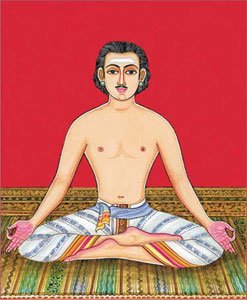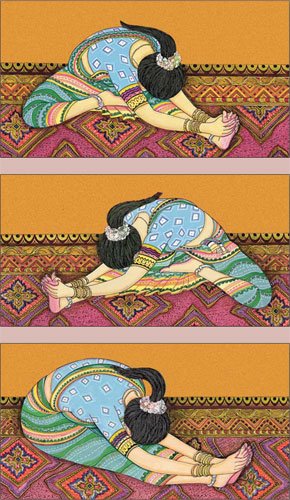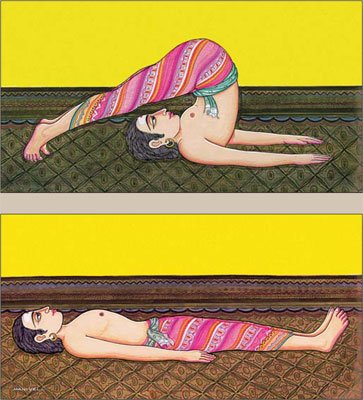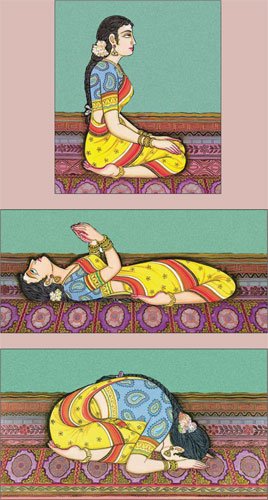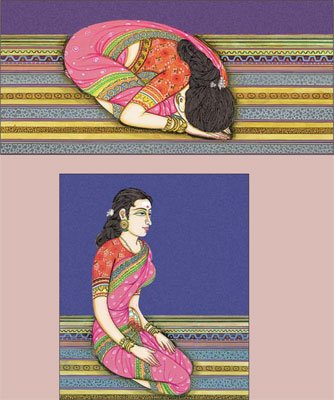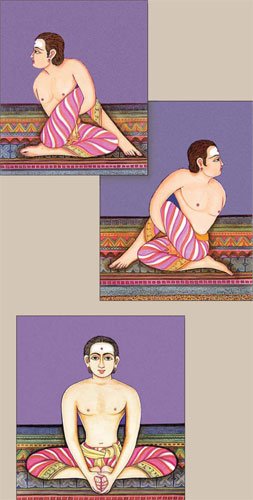
C H A P T E R 34
Hatha Yoga
________________§
A 24-Posture System of Body Tuning and Preparation for Meditation §
________________§
 ATHA YOGA IS A SYSTEM OF HANDLING THE PHYSICAL body so that the mind and the nerve system are calmed and quieted. It is primarily a means to prepare oneself for meditation. Hatha yoga is founded on a principle of putting the physical body into a position so that the nerve currents in the physical body get tuned up to a perfect pitch. It is like tuning the strings on a violin; if you tune the violin just right, then each string will be in harmony with the other strings.§
ATHA YOGA IS A SYSTEM OF HANDLING THE PHYSICAL body so that the mind and the nerve system are calmed and quieted. It is primarily a means to prepare oneself for meditation. Hatha yoga is founded on a principle of putting the physical body into a position so that the nerve currents in the physical body get tuned up to a perfect pitch. It is like tuning the strings on a violin; if you tune the violin just right, then each string will be in harmony with the other strings.§
This chapter consists of original illustrations and instructions for 24 asanas organized in eight sets of three to be performed in series. While there are many more complex hatha yoga routines, these 24 relatively easy poses provide a good, balanced system for daily use. To prepare yourself for an effective meditation, this routine is all you will ever need. For the very best results, hatha yoga should be taught personally by a qualified teacher. The instructions and illustrations given here are a rudimentary aid. For more elaborate regimens, inquire at a recognized school specializing in hatha yoga. §
Asanas elongate, tone and strengthen muscle tissue, massage the organs, stimulate the nerves and balance the pingala and ida nadis. From the hundreds of known asanas, these 24 affect all the major parts of the body. Each pose is to be held in relaxed stillness for 30 to 120 seconds, without straining. As maximum stretch and flexibility are approached, a subtle stimulation of the physical and psychic nerve system begins to occur. §
Perform the postures daily in the privacy of your own room, without drawing attention to yourself. Naturally, they should not be performed after meals. Don’t worry if you can’t perform them perfectly, or if some are difficult for you. Do the best you can. Progress at your own pace, rather than in a competitive manner. With practice, you will find the body becoming more supple, reflecting the mind’s flexibility, alertness and freedom from subconscious repressions. §
By controlling breath we control thought and life energy, or prana. Yogis call this pranayama. The pranayama for these asanas is simple: breathe in for nine equal counts (ideally counting with mathura, the heartbeat), then hold one count, breathe out nine counts, hold one, and so on. Breathe deeply, fully and diaphragmatically, rather than shallowly expanding the upper chest. Harnessing the breath’s three phases (inhalation, retention and exhalation) directs the flow of prana, calming and relaxing body and mind. §
When physical tensions are released through hatha yoga, mental-emotional tensions are automatically dissolved. This is a great secret and a wonderful tool that you can use every day of your life. Free the mind of thoughts and tensions and you will be more aware, more alive, more serene. As you perform the hatha yoga asanas, put out of your mind all thoughts relating to your work, family, friends, associates, problems and challenges that normally concern you. Relax. Relax. Relax. Be completely at peace with yourself and fully enjoy this contemplative art.§
Try to sense the inner and outer nerve system reaching a crescendo of energy as you sustain each pose. When this peak is felt, gracefully shift during the outbreath to the next asana. The whole series of 24 poses is like a dance; and a deliberate flow from one to the next is a key to perfect serenity. Each set includes a color visualization to quiet the mind and intensify healing. The color of the background wall in each illustration is the color to visualize while in that pose. Mentally fill your body with that color, from your head to your toes; or imagine yourself suspended in space, surrounded on all sides by the color shown with the pose. If tensions in the body or mind are discovered, visualize them flowing away with the outbreath. At the end, plunge into meditation. Tradition sets the best times for hatha yoga at dawn, noon and twilight. Minimally, only 12 minutes of time is needed. §
An Important Caution: Individuals with neck or back problems should abstain from poses that place strain on the spine, such as the headstand, shirshasana, and the shoulder stand, sarvangasana. §
1. Bend the right leg back around the thigh and tuck the right foot along the contour of the buttocks. Bring the left leg in front of the torso, tucking it close to the groin. Hands are on the knees, palms up, thumb and index fingers touching, in the akasha mudra. Keep the spine (the powerhouse of the body) straight, the head erect and balanced at the top of the spine. 2. Next reverse leg positions. 3. In the third pose tuck the right leg into the groin area, then place the left leg in front of it, with the left heel in front of the right heel. This is a variation of the accomplished pose, siddhasana, Hindi. Keep both legs resting fully on the floor. Visualize deep, ruby red for physical vitality during this first set. §
4. From the last pose of set one straighten the left leg, lean forward and grasp the left foot with the thumb and index fingers of both hands. This is the janu shirshasana, Hindi, head-to-knee pose. Relax into the position, letting the head drop lower and lower until it rests on the knee. In full flexibility the elbows lower to the floor, and the torso rests on the leg. 5. Repeat these steps on the right side. 6. Then extend both legs (a little bend is OK at first) into the forward bend, pashchimottanasana, Hindi. Grasp the toes with the thumb and index fingers and let the head gently fall to the knees. With practice, the elbows will lower to the floor. In this set, visualize marigold orange for pure, selfless service.§
 7. Lying face-up on the floor, raise the legs and—with the hands in the mid-back region to support the body—raise the torso until the entire body is vertical over the shoulders. This is the shoulder stand, sarvangasana, Hindi. Keep the spine straight, feet together, torso perpendicular to the floor. 8. Lower the legs slowly over the head until the toes touch the floor. Then lower the arms, palms down. This is the plough pose, halasana, Hindi. 9. End the set with the corpse pose, shavasana, Hindi, by lowering the legs to the floor in front of you. Let the hands rest loosely by the sides, palms down. Every muscle is relaxed. Visualize sun-glow yellow for purified intellect during this third set. §
7. Lying face-up on the floor, raise the legs and—with the hands in the mid-back region to support the body—raise the torso until the entire body is vertical over the shoulders. This is the shoulder stand, sarvangasana, Hindi. Keep the spine straight, feet together, torso perpendicular to the floor. 8. Lower the legs slowly over the head until the toes touch the floor. Then lower the arms, palms down. This is the plough pose, halasana, Hindi. 9. End the set with the corpse pose, shavasana, Hindi, by lowering the legs to the floor in front of you. Let the hands rest loosely by the sides, palms down. Every muscle is relaxed. Visualize sun-glow yellow for purified intellect during this third set. §
10. Kneel and spread the feet apart, sitting between the ankles, hands on the knees, palms down. This is the heroic pose, virasana, Hindi. 11. Still kneeling, arch back as far as possible until the head touches the floor behind you in the couch pose, paryankasana, Hindi. Hold the palms together over the chest in namaskara. 12. When you reach the right pitch of energy, bring the torso up (ideally without aid from the arms) and bend forward until the forehead touches the floor, palms down near the head, buttocks on the floor between the ankles. In this set, visualize emerald green for physical and emotional health.§
13. Move the upper body forward, inhale, arch the back slowly and extend the arms until straight, in the cobra pose, bhujangasana, Hindi. Hold for two or three breaths, then lower the torso gracefully. 14. Bring the legs up, reach back and clasp the ankles. Inhale as you pull the legs up and raise the head and upper body into the bow pose, dhanurasana, Hindi. Look up and back. Hold for two or three rounds of breathing. Exhale as you release the legs and lower to the prone position. 15. Rise into a kneeling position, buttocks on the ankles, in the panchanga pranamasana, Hindi, forehead on the floor, arms forward, palms down. In this set, visualize bright royal blue for peace of mind.§

16. From the last asana, move the body forward and form a triangle of forearms and head, hands clasped behind the head, fingers interwoven. The hairline touches the floor. Raise the body slowly, keeping the knees bent. Pause, then extend the legs vertically into the headstand, salamba shirshasana, Hindi. Keep most of the body weight on the arms, not the head. 17. When ready, bend and tuck in the knees and carefully lower into the curled pelvic pose for at least 8 cycles of breath to allow the blood to equalize. 18. Slowly rise into the upright pelvic pose, hands on knees, palms down. Keep the head down momentarily against the chest in a bandha, or lock, and then straighten the neck. Visualize purple for the flooding forth of spiritual knowledge. §
19. Sit on the left hip and place the right foot over the left knee. Insert the left arm under the bent right knee. Extend the right arm behind the back and clasp the left hand with the right (as an easier alternative, grasp the right knee with the left arm). Keep the spine as straight as possible. This is the spinal twist, matsyendrasana, Hindi. Turn the head slowly to the left each time you inhale, and back to the right as you exhale. 20. Repeat the posture on the opposite side. 21. Finally, bring the soles together and hold the feet with both hands in the bound-eagle pose, baddha konasana, Hindi. Let the knees lower to the floor. Throughout this set visualize lavender to purify karma through divine sight.§
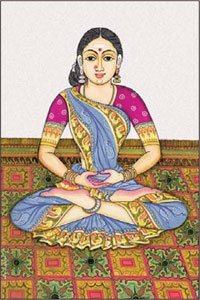 22. Extend the right leg and place the left ankle high on the right thigh. Stretch forward and clasp the right foot with the thumb and index finger. This is a variation of the head-to-knee pose, janu shirshasana, Hindi. 23. Repeat this same procedure on the left side, with the right foot on the left thigh. 24. Finally, assume the lotus posture, padmasana, Hindi. The right foot is already on the left thigh. To complete the lotus, carefully place the left foot on the right thigh. Spine straight with the hands resting in the lap, palms open, right hand on top, with the thumbs gently touching in dhyana mudra. Visualize white during this set to attain moksha, freedom from rebirth. §
22. Extend the right leg and place the left ankle high on the right thigh. Stretch forward and clasp the right foot with the thumb and index finger. This is a variation of the head-to-knee pose, janu shirshasana, Hindi. 23. Repeat this same procedure on the left side, with the right foot on the left thigh. 24. Finally, assume the lotus posture, padmasana, Hindi. The right foot is already on the left thigh. To complete the lotus, carefully place the left foot on the right thigh. Spine straight with the hands resting in the lap, palms open, right hand on top, with the thumbs gently touching in dhyana mudra. Visualize white during this set to attain moksha, freedom from rebirth. §

